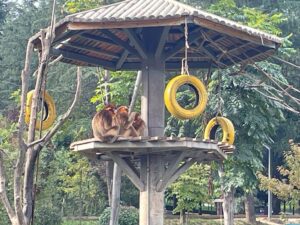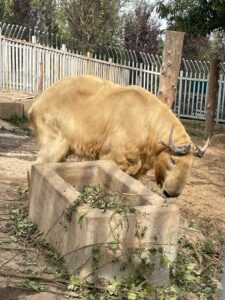BEIJING, Nov 1 (APP): The Qinling Mountains, one of the most important ecosystem function conservation areas in China and a hotspot of biodiversity in the world has made prominent improvements in wildlife protection in recent years.
The Qinling Mountains, mainly in northwest China’s Shaanxi province houses a huge variety of wild animals and plants.

The mountains are home to about 20% of China’s wild giant panda population, golden monkeys, takin and only known wild population of crested ibis – one of the rarest birds in the world. It is the center water tower of our country and the important water head site of the Yangtze River and Yellow River valley.
Data from Shaanxi Development and Reform Commission and Shaanxi Provincial Meteorological Bureau showed that the quality of the ecological environment in the Qinling Mountains has been improving year by year.

The water conservation capacity the area is relatively stable, and the water conservation capacity has reached 278.6 mm in 2022, which is higher than the multi-year average.
Statistics released by the Shaanxi Provincial Forestry Bureau also show that at present, the forest coverage rate of Qinling Mountains has reached 82%, making it the greenest region in the country.
A number of villagers who have been shifted to newly built houses expressed satisfaction over the facilities including job opportunities, education and health facilities.
Niu Zhiming, a senior project officer of the East Asia Bureau of the Asian Development Bank said, the construction of the Qinling National Arboretum located in Zhouzhi county, about 70 kilometers south of downtown Xi’an, has upgraded infrastructure across the region, including 18 kilometers of roads along the Tianyu River, more than 120 kilometers of mountain trails, and home-based ecotourism village facilities.
“Ecotourism commercial activities and conservation projects provide sustainable alternative livelihoods for local communities, ultimately easing the pressure on land and biodiversity conservation,” Niu Zhiming said.

The Qinling Biodiversity Conservation and Demonstration Project, funded by the Asian Development Bank (ADB), is a comprehensive national ecological demonstration project of biodiversity conservation and scientific research in Shaanxi province with foreign investment, and it is also the main supporting project before the opening of the Qinling National Botanical Garden.
The project signed in July 2010, mainly includes two parts of plants and animals, the plant part is undertaken by the Qinling National Botanical Garden, and the animal part is undertaken by the Qinling Giant Panda Research Center.
Zhang Qinling, director of Qinling National Botanical Garden informed that the Qinling project will use ADB loans of US$40 million and the provincial supporting funds of 420 million yuan. The total investment of the project is 692 million yuan. The Global Environment Facility (GEF) also awarded US $4.27 million in grants.
“It is no exaggeration to say that without the ADB project, there would be no construction and development of the Qinling National Botanical Garden,” Zhang Qinling said.
Zhu Lin, director of the Scientific Research Center of the park, introduced that ex-situ conservation of plants is the top priority of the Qinling National Botanical Garden. Up to now, the garden has a total of 173 families, 525 genera, 4043 species of plants, of which 16 species of ex-situ national first-class protected wild plants.
According to the project completion evaluation report, since the implementation of the Qinling project, the number of takin, crested ibis, golden monkey and giant panda in the area has increased by 150%, 52%, 71% and 27% respectively.
“The implementation of the Qinling project has greatly improved the conditions of animal husbandry, from the original captive breeding to the semi-wild breeding state, and the open visiting area has also enhanced the visitor’s experience.”
The Qinling Giant Panda Research Center has received more than 800,000 visitors from May 2021 to October 2023, with an average annual revenue of 20 million yuan, Bai Xuxiang, minister of planning and construction said. Around the hotel, catering, accommodation and other tourism services annual income of more than 50 million yuan.
Another set of data provided by the Qinling Project Office also shows that since the implementation of the project, the number of eco-tourism tourists in the project area has exceeded 1 million annually.
Rural per capita income has increased; Qinling National Botanical Garden and Shaanxi Wildlife Rescue Center directly created more than 300 operational jobs, and related project activities created more than 1,500 jobs; Local employment opportunities have increased through the development of commercial activities such as small-scale community ecotourism.
Safar Parvez, chief representative of ADB’s representative office in China, who recently visited Qinling National Botanical Garden, told APP that the Qinling Project encourages local communities to participate in biodiversity conservation by creating revenue opportunities from the eco-tourism business supported by the project. Providing ecosystem services is in the interest of individuals in the market.
“Through the implementation of the project, ecosystem management in the Qinling Mountains has been strengthened, rural incomes have increased and poverty reduction has been achieved,” he added.
Zhang Qinling also said that the Qinling Mountains project has played an exemplary role in biodiversity protection throughout the Qinling Mountains.
At the same time, it has also enhanced the visibility of the Qinling National Botanical Garden and played a leading role in the construction of the National Botanical Garden system, striving for supporting funds, provincial related funds and scientific research project cooperation.
According to the Qinling National Park Establishment Plan, the park covers 6 cities, 21 counties (districts), 65 natural conservation areas, scenic and historical areas and 41 geological relics, covering a total planning area of about 13,500 square kilometers.
Qinling Mountain National Park is planned to be two districts, the core urban conservation area is 8240 square kilometers, accounting for 61%; The general control area is 5,275 square kilometers, or 39%.

